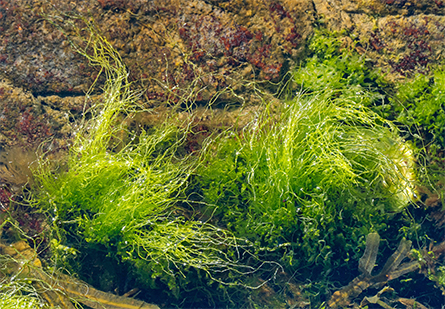From the journals: JBC
Breaking down seaweed. A piece of the centromere recruitment puzzle. Making pain meds with microbes. Read about articles on these and other topics recently published in the Journal of Biological Chemistry.
Breaking down seaweed: An alternative enzyme cascade
Marine algae are responsible for half of the global photosynthetic carbohydrate production. The Ulva species — commonly known as sea lettuce — grow quickly and produce large amounts of carbohydrate-rich biomass, making them an emerging renewable energy and carbon resource.

To exploit this potential energy source, researchers must better understand the metabolic processes leading to the seaweed’s degradation by microbes in nature. That’s what motivated Marcus Bäumgen, Theresa Dutschei and colleagues at Germany’s University Greifswald to undertake a recent study published in the Journal of Biological Chemistry.
A few years ago, the same team reported a complex enzymatic cascade that enables a marine flavobacterium to degrade the algal polysaccharide ulvan. In the new JBC paper, the Greifswald team reported their discovery of a separate degradation pathway for ulvan oligosaccharides in that same marine bacterium, Formosa agariphila. The authors found a new dehydratase — P29_PDnc — acting on the nonreducing end of ulvan oligosaccharides.
“This elucidation of an alternative degradation pathway illustrates the complexity of the biological systems for marine ulvan degradation,” the authors wrote. “It indicates the necessity of backup mechanisms for metabolic processes in order to get access and compete for the diversity of complex marine carbon sources in nature.”
The team’s research shows that this dehydratase is involved in degrading carboxylated polysaccharides into monosaccharides, providing further insights into the molecular mechanisms of the ocean’s carbon cycle.
“The characterizations of ulvan-active enzymes and the clarification of their substrate scopes allow using these enzymes for the production of ulvan-derived chemical products from currently rarely used green algal biomass,” the authors wrote.
A piece of the centromere recruitment puzzle
The transcription of noncoding RNA at the centromere, a chromosomal locus essential for accurate segregation of chromosomes during cell division, is an important step for appropriate centromere function. Alterations in this function lead to genomic instability and aneuploidy, frequently observed in human cancers.
Shuhei Ishikura and colleagues at Fukuoka University in Japan in 2020 determined that zinc-finger transcriptional regulator ZFAT binds to the centromere to regulate ncRNA transcription. However, it has not been clear how ZFAT is recruited to the centromere.
Recently, the team reported in JBC that the centromeric protein CENP-B is an essential player in this process.
The authors performed ectopic expression and co-immunoprecipitation analysis, suggesting that ZFAT requires and interacts with CENP-B for ncRNA transcription. CENP-B knockdown showed decreased ncRNA expression levels at the centromere.
“Furthermore, the evident interaction between ZFAT and CENP-B was observed in both human and mouse cells,” they wrote.
The researchers conclude that CENP-B helps establish ZFAT centromeric localization to regulate ncRNA transcription.
Sex-specific differences in glucose homeostasis
Metabolic syndrome is a cluster of conditions that increase the risk of heart disease, stroke and diabetes. It is well established that sex as a physiologic factor is associated strongly with metabolic syndrome.
Hv1 is a voltage-gated proton channel involved in insulin secretion. Huimin Pang and colleagues at Nankai University in China previously showed that male mice with Hv1 knocked out end up with hyperglycemia and insulin intolerance. But they wanted to know if this was also true for female knockout mice and, if so or if not, what role sex steroids play in the results.
The team recently reported that, in fact, fasting blood glucose levels in females were lower than those for males despite decreased insulin secretion in both sexes. In addition, they found that knockout mice of both sexes had increased expression of gluconeogenesis-related genes in liver compared with wild-type mice.
This sex-related difference in glucose homeostasis is associated with the glucose metabolism in liver tissue, the authors say, likely due to the physiological levels of testosterone in knockout male mice.
Making pain meds with microbes
The pain medicines codeine and morphine are closely related benzylisoquinoline alkaloids, or BIAs, derived from opium poppy. Microbial biosynthesis systems to produce these medicines are an area of active research, given that agricultural methods are affected by climate, supply chain and geopolitical instability. But this emerging synthetic biology strategy requires having a detailed understanding of the biosynthetic pathway in the plant.
Codeinone reductase, or COR, catalyzes the last step of the biosynthetic pathway, but the determinants that mediate substrate recognition and catalysis are not well defined.
Samuel C. Carr and colleagues at the University of Calgary in Canada recently reported the crystal structure of apo-COR in the Journal of Biological Chemistry.
They performed structural comparisons to closely related plant aldo-keto reductases, or AKRs, and distantly related homologs, revealing a novel conformation in one of the loops adjacent to the BIA binding pocket. The authors used site-directed mutagenesis and identified specific substitutions in COR that led to changes on AKR activity for both substrates, codeinone and neopinone.
The authors wrote: “The deeper understanding of structure–function relationships in COR should lead to further improvements in the performance of microbial BIA biosynthesis systems. … Although still not commercially viable, microbial biosynthesis systems are quickly gaining ground on the traditional agricultural methods of obtaining these medicines and will one day lead to a pharmaceutical production process (that) is more environmentally friendly, globally equitable and easier to secure from illicit diversion.”
Enjoy reading ASBMB Today?
Become a member to receive the print edition four times a year and the digital edition monthly.
Learn moreGet the latest from ASBMB Today
Enter your email address, and we’ll send you a weekly email with recent articles, interviews and more.
Latest in Science
Science highlights or most popular articles

Fueling healthier aging, connecting metabolism stress and time
Biochemist Melanie McReynolds investigates how metabolism and stress shape the aging process. Her research on NAD+, a molecule central to cellular energy, reveals how maintaining its balance could promote healthier, longer lives.

Mapping proteins, one side chain at a time
Roland Dunbrack Jr. will receive the ASBMB DeLano Award for Computational Biosciences at the ASBMB Annual Meeting, March 7–10, just outside of Washington, D.C.

Exploring the link between lipids and longevity
Meng Wang will present her work on metabolism and aging at the ASBMB Annual Meeting, March 7-10, just outside of Washington, D.C.

Defining a ‘crucial gatekeeper’ of lipid metabolism
George Carman receives the Herbert Tabor Research Award at the ASBMB Annual Meeting, March 7–10, just outside of Washington, D.C.

The science of staying strong
Muscles power every movement, but they also tell the story of aging itself. Scientists are uncovering how strength fades, why some species resist it and what lifestyle and molecular clues could help preserve muscle health for life.

Bacteriophage protein could make queso fresco safer
Researchers characterized the structure and function of PlyP100, a bacteriophage protein that shows promise as a food-safe antimicrobial for preventing Listeria monocytogenes growth in fresh cheeses.

